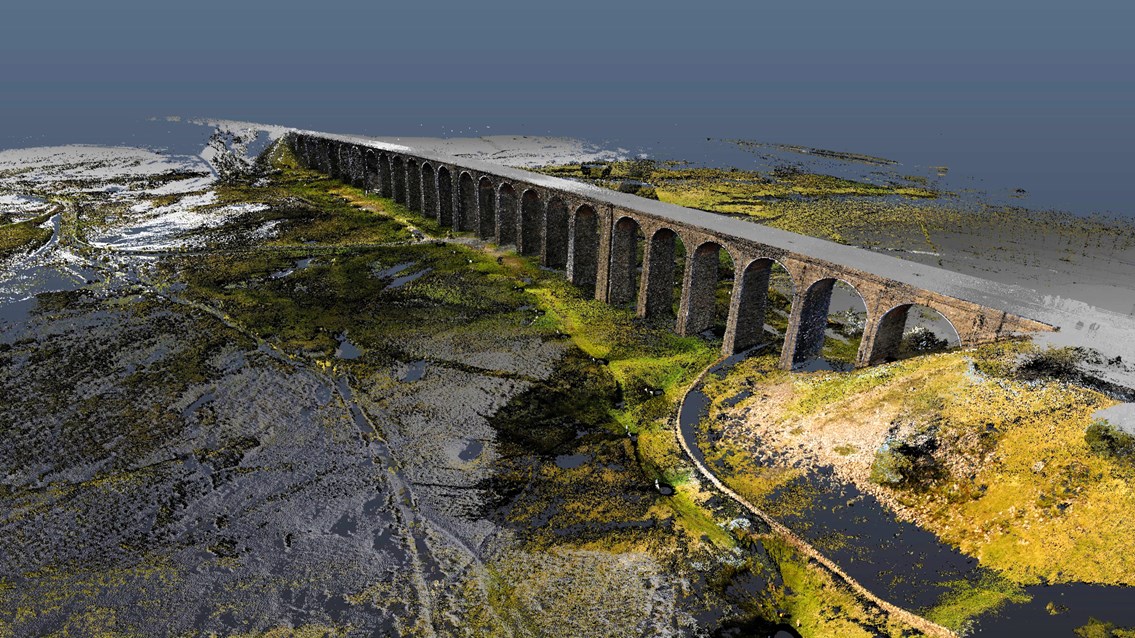Monday 23 Nov 2020
Laser and drone technology recreates Ribblehead viaduct like never before
- Region & Route:
- North West & Central
- | North West & Central: North West
Laser scanners and drones have been used to map every inch of the iconic Ribblehead viaduct as part of a major restoration project to secure its future for passengers and tourists.
An essential upgrade to brickwork and drainage is underway on the 144-year-old structure which carries the historic Settle to Carlisle railway 400 metres across the Ribble valley.
As part the £2.1m Great North Rail Project investment, North Yorkshire’s most recognisable railway icon was 3D scanned and turned into a computer model by surveyors.
This detailed digital recreation will help engineers make repairs now and closely monitor areas needing any further attention in the future.
Phil James, Network Rail’s North West route director, said: “We’re always looking to innovate on the railway and seeing drones and lasers being used to care for such an historic structure is really impressive.
“I was at Ribblehead viaduct when we started work a week ago and saw for myself the huge scaffolding platforms now in place so my team can improve brickwork, mortar and drainage. Great care and attention is going in to make sure our work is right from a heritage perspective. This digital model plays a major role in that as we secure the Grade II listed-structure’s future for passengers and tourists as part of the Great North Rail Project.”
Network Rail has today (Monday 23 November) released the impressive footage of the Victorian viaduct as realised by the 21st century technology.
A LiDAR survey* was carried out by contractor Commendium in conjunction with heritage consultancy firm Wardell Armstrong.
Ribblehead viaduct is the biggest man-made structure Commendium has ever scanned.
Drone flights also took place as part of the survey taking high definition photographs of the Grade II listed structure.
The data gathered was then used to build up the 3D computer model by Network Rail’s specialist computer aided design (CAD) team.
Richard Walters, chief executive officer for Commendium, said: “We have all known and loved this location for most of our lives, it is even part of our childrens’ cultural awareness with them learning songs about it at school. So to survey it has been a privilege. The resulting LiDAR scan not only shows areas which need repair, but also areas where water could damage the stonework in the future, so leading to other preservation works.”
The maintenance work on Ribblehead viaduct taking place between now and February 2021 involves:
- brickwork repairs
- removal of vegetation and repairing the damage caused by plants and weeds
- upgrades to drainage across the viaduct’s 24 arches
- repainting metal and pipework
No major disruption is expected for passengers using the Settle-Carlisle line during the viaduct's 2020/21 maintenance.
Passengers are reminded to continue following government Covid safety advice and to check before travelling at www.nationalrail.co.uk or with their train operator.
Notes to Editors
How the 3D computer model of Ribblehead viaduct was created
*This was done using LiDAR technology.
Over 100 separate scans were taken from locations underneath and on top of the viaduct.
In a LiDAR system, light is emitted from a rapidly firing laser like a strobe light.
This light travels to the ground and reflects off of things like buildings and tree branches. The reflected light energy then returns to the LiDAR sensor where it is recorded.
This data is then used to build up the 3D computer model.
Ribblehead viaduct key statistics
Ribblehead viaduct opened in 1876 bridging the gap between Ribblehead and Dent over the exposed and windy Batty Moss.
- 104 ft. high
- 402 metres long
- 24 arches
- Built between 1870 – 1875
- Opened on 1st May 1876
Looking after Ribblehead viaduct
At 400m long, Ribblehead viaduct’s 24 arches sweep through the Three Peaks region of Yorkshire Dales National Park.
We’re proud to look after such a historic piece of Britain’s railway. Ensuring our Victorian structures remain in safe working order and last for generations to come is a great responsibility.
To do this, we undertake visual exams of the viaduct annually and detailed inspections every six years. We also typically carry out a major renewal every 10 years and any minor works as an when necessary.
Severe weather is one of the challenges we face as custodian of Ribblehead viaduct, which crosses open land in an exposed position.
For more information on the history of the Settle to Carlisle line click here.
Contact information
Passengers / community members
Network Rail national helpline
03457 11 41 41
Latest travel advice
Please visit National Rail Enquiries
Journalists
Network Rail press office - North West & Central Region
0330 854 0100
NWCmediarelations@networkrail.co.uk
About Network Rail
We own, operate and develop Britain's railway infrastructure; that's 20,000 miles of track, 30,000 bridges, tunnels and viaducts and the thousands of signals, level crossings and stations. We run 20 of the UK's largest stations while all the others, over 2,500, are run by the country's train operating companies.
Usually, there are almost five million journeys made in the UK and over 600 freight trains run on the network. People depend on Britain's railway for their daily commute, to visit friends and loved ones and to get them home safe every day. Our role is to deliver a safe and reliable railway, so we carefully manage and deliver thousands of projects every year that form part of the multi-billion pound Railway Upgrade Plan, to grow and expand the nation's railway network to respond to the tremendous growth and demand the railway has experienced - a doubling of passenger journeys over the past 20 years.
Follow us on Twitter: @networkrail
Visit our online newsroom: www.networkrailmediacentre.co.uk

